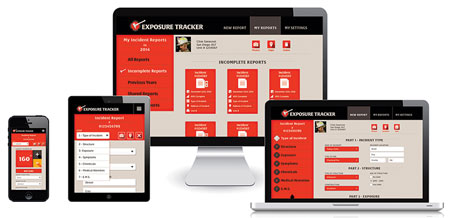Scenario: You pull up to the scene of a well-involved house, take a preconnected hoseline through the front door, and proceed to knock down the fire. You find the resident in a back bedroom closet, but she’s suffered major burns, and is obviously deceased. You leave her in place for the investigators. Twenty minutes later, drenched in sweat and covered in ash, you exit the house to change your self-contained breathing apparatus (SCBA) bottle and head back in for overhaul. After that bottle finishes, you and your crew decide that the smoke is mostly dissipated, so you take off your SCBA and finish overhauling the structure. An hour later, you’re back at the station. You and your crew are putting the rig back together, and then you sit down in the apparatus room for some coffee before getting off shift.You head home from the shift with that sunburned, dried-out feeling on your face and some blisters on your ears, but otherwise you feel like all you need is a nap to fully recover.
Most of us have had enough of these experiences that we’ve forgotten the majority of them. In reality, the previous 24 hours had serious effects on your body and mind. The multiple exposures to smoke are mounting factors for cancer; the constant highs and lows with heavy exertion are a path to heart disease; the smoke and particulates can lead to chronic lung disease; the diesel exhaust and soot in the apparatus room can lead to bladder cancer; and the psychological effect of seeing a traumatic fatality is one more trigger for post-traumatic stress disorder (PTSD). Our dream job is one of the most self-destructive professions.
As a firefighter who was forced to retire early because of serious health complications from exposures, I now dedicate my life to educating firefighters and creating programs to prevent chronic illnesses. In 2014, I founded The Exposure Tracker program to help firefighters track all of their toxic exposures, injuries, and communicable disease exposures; I also launched a related Web-based program and iOS and Android apps.
The Exposure Tracker collects objective information of all the toxic exposures, injuries, and communicable disease exposures firefighters face every day. By logging incident details such as the types of structures involved and the activities performed, firefighters can use the program’s analytics to have a greater level of awareness for their health and welfare. A National Institute for Occupational Safety and Health study published in February 2015 shows a linear relationship between the number of fires a firefighter responds to and his lung cancer risk. With accurate exposure tracking, firefighters, their departments, and their physicians may be able to recognize probabilities of developing a chronic illness and take appropriate preventive measures.
 |
| (1) Photo courtesy of The Exposure Tracker. |
On calls, firefighters are exposing their lungs not only to carcinogens but also to carbon monoxide, nitric oxide, nitrogen dioxide, sulfur oxides, hydrocarbons, and polycyclic aromatic hydrocarbons in the gases and soot of diesel exhaust. Do fire stations feature exercise equipment in the apparatus room? Do fire stations have exhaust-collection systems for all of the apparatus? The International Agency of Research on Cancer, which is part of the World Health Organization, classifies diesel exhaust as “carcinogenic to humans” based on evidence linked to increased risk of lung cancer and bladder cancer. Tracking information about the facilities to which firefighters are exposed can help track chronic occupational illnesses related to mold, diesel exhaust, and other environmental hazards. A firefighter’s station assignment history will not only provide tracking for them but may assist in preventing illnesses in other firefighters when an issue is discovered.
Although The Exposure Tracker program was launched with some basic parameters to keep the program simple and user-friendly, it has continued to grow based on firefighter feedback. Since the launch, The Exposure Tracker has built in certification tracking, vaccination tracking, psychological exposure tracking to address PTSD, communicable disease and injury reporting, and most recently real-time rehab tracking.
With the rehab tracking feature, a rehab officer can manage an incident’s rehab in compliance with National Fire Protection Association 1584, Standard on the Rehabilitation Process for Members During Emergency Operations and Training Exercises, identifying all the firefighters on scene, their work time, and their vital signs. There are also alerts built into the system to notify the rehab officer when vital sign inputs are outside a normal, safe range.
With the communicable disease and injury reporting, the program can make accurate notifications, expediting treatment as well as the workers’ compensation process, maximizing efficiency and minimizing lost work time.
To further expand the program’s health and welfare benefits, The Exposure Tracker team has received help from the Firefighter Behavioral Health Alliance and the Illinois Firefighter Peer Support Team to build in parameters to track psychological exposures with the goal of identifying when firefighters are likely to develop PTSD.
CLIVE SAVACOOL is a battalion chief (ret.) with the Contra Costa County (CA) Fire Protection District and founder of The Exposure Tracker.
Fire Engineering Archives

